
The genus Argiope includes rather large spiders that often have a strikingly coloured abdomen. These spiders are distributed throughout the world. Most countries in tropical or temperate climates host one or more species that are similar in appearance. The etymology of Argiope is from a Latin word argentum meaning silver. The carapace of Argiope species is typically covered in silvery hairs, and when crawling in the sun, they reflect it in a way that gives them a metallic, white appearance.

Orb-weaver spiders are members of the spider family Araneidae. They are the most common group of builders of spiral wheel-shaped webs often found in gardens, fields, and forests. The English word "orb" can mean "circular", hence the English name of the group. Araneids have eight similar eyes, hairy or spiny legs, and no stridulating organs.

A bolas spider is a member of the orb-weaver spider that, instead of spinning a typical orb web, hunts by using one or more sticky "capture blobs" on the end of a silk line, known as a "bolas". By swinging the bolas at flying male moths or moth flies nearby, the spider may snag its prey rather like a fisherman snagging a fish on a hook. Because of this, they are also called angling or fishing spiders. The prey is lured to the spider by the production of up to three sex pheromone-analogues.

Argyrodes, also called dewdrop spiders, is a genus of comb-footed spiders that was first described by Eugène Louis Simon in 1864. They occur worldwide, and are best known for their kleptoparasitism. They can spin their own webs, but tend to invade and reside in their hosts' webs. This relationship can be commensal or even mutual if the dewdrop spider feeds on small trapped insects that are not eaten by the host. Some species can even prey upon the host.
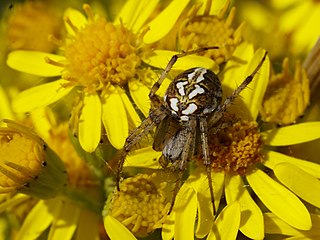
Neoscona, known as spotted orb-weavers and barn spiders, is a genus of orb-weaver spiders (Araneidae) first described by Eugène Simon in 1895 to separate these from other araneids in the now obsolete genus Epeira. The name Neoscona was derived from the Greek νέω, meaning "spin", and σχοῖνος, meaning "reed" They have a mostly pantropical distribution and one species, Neoscona adianta, has a palearctic distribution. As of April 2019 there are eight species that can be found in the United States and Canada:
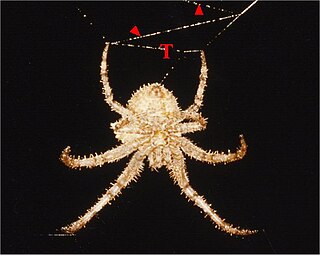
Kaira, sometimes called frilled orbweavers, is a mostly neotropical genus of orb-weaver spiders first described by O. Pickard-Cambridge in 1889. It includes sixteen described species that occur from South America up to the southern and eastern USA. It is presumably related to Aculepeira, Amazonepeira and Metepeira.

Dolichognatha is a genus of tropical and subtropical long-jawed orb-weavers that was first described by Octavius Pickard-Cambridge in 1869. Originally placed with the Archaeidae, it was transferred to the Araneidae in 1967, and to the Tetragnathidae in 1981.
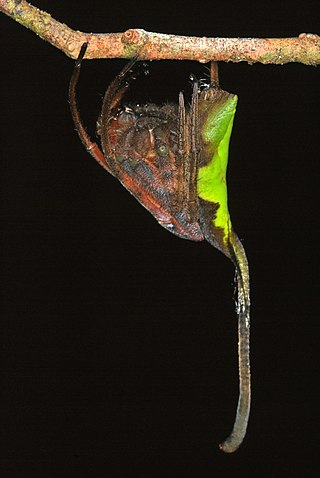
Poltys is a genus of orb-weaver spiders first described by C. L. Koch in 1843. Many species are cryptic and are known to masquerade as leaves and twigs during the day, and build an orb web at night to capture prey. The shape of the abdomen which often gives the impression of a rough and broken branch can vary among individuals within a species. The web is eaten up before dawn and reconstructed after dusk.
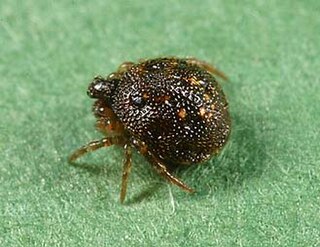
Phoroncidia is a genus of comb-footed spiders that was first described by J. O. Westwood in 1835.

Cladomelea is a genus of African orb-weaver spiders first described by Eugène Simon in 1895. Adult females of the genus are bolas spiders, capturing their prey with one or more sticky drops at the end of a single line of silk rather than in a web. Males and juvenile females capture their prey directly with their legs.
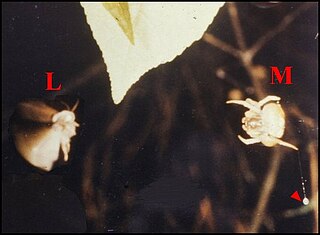
Mastophora cornigera is a species of orb weaver in the spider family Araneidae. It is found in a range from the United States to Nicaragua. Like all known species of the genus Mastophora, adult females are bolas spiders, capturing their prey with one or more sticky drops at the end of a single line of silk rather than in a web. Males and juvenile females capture their prey directly with their legs.

Mastophora bisaccata is a species of orb weaver in the spider family Araneidae. It is also known as Mastaphora obesa. It is found in the United States and Mexico. Like all known species of the genus Mastophora, adult females are bolas spiders, capturing their prey with one or more sticky drops at the end of a single line of silk rather than in a web. Males and juvenile females capture their prey directly with their legs.
Mastophora leucabulba is a species of orb weaver in the spider family Araneidae. It is found in a range from the United States to Honduras. Like all known species of the genus Mastophora, adult females are bolas spiders, capturing their prey with one or more sticky drops at the end of a single line of silk rather than in a web. Males and juvenile females capture their prey directly with their legs.
Mastophora timuqua is a species of orb weaver in the spider family Araneidae. It is found in the United States. Like all known species of the genus Mastophora, adult females are bolas spiders, capturing their prey with one or more sticky drops at the end of a single line of silk rather than in a web. Males and juvenile females capture their prey directly with their legs.
Mastophora yeargani is a species of orb weaver in the spider family Araneidae. It is found in the United States. Like all known species of the genus Mastophora, adult females are bolas spiders, capturing their prey with one or more sticky drops at the end of a single line of silk rather than in a web. Males and juvenile females capture their prey directly with their legs.
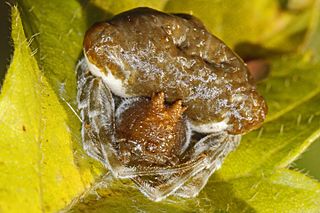
Mastophora phrynosoma is a species of orb weaver in the spider family Araneidae. It is found in the United States. Like all known species of the genus Mastophora, adult females are bolas spiders, capturing their prey with one or more sticky drops at the end of a single line of silk rather than in a web. Males and juvenile females capture their prey directly with their legs.

Cyrtarachninae is a subfamily of spiders in the family Araneidae. The group has been circumscribed in several different ways. It originated as the group Cyrtarachneae, described by Eugène Simon in 1892. The group was later treated at different ranks: as a tribe, both under Simon's name and as Cyrtarachnini, and as the subfamily Cyrtarachninae. Circumscriptions have varied. The broadest circumscription, Cyrtarachninae sensu lato (s.l.), includes three of Simon's original groups, including the bolas spiders. Unlike most araneids, members of the subfamily do not construct orb webs, some not using webs at all to capture prey, some using one or more sticky drops on a single line, while others construct webs with few widely spaced non-spiral threads, some triangular. Many have been shown to attract prey by producing analogues of insect sex pheromones, particularly to attract male moths. Adult females may mimic snails, bird droppings and other objects, and so are able to remain exposed during the day time, capturing prey at night.
Mastophora extraordinaria is a species of spider in the orb-weaver spider family Araneidae. It is found in South America. Like some other species of the genus Mastophora, adult females resemble bird droppings. Mastophora species, including M. extraordinaria, are "bolas spiders" – adult females capture their prey by using a sticky drop on the end of a single line which they swing at the target, usually a male moth attracted by the release of an analogue of the attractant sex pheromone produced by the female moth. Juveniles and adult males do not use a bolas, catching prey with their legs alone.
Ordgarius monstrosus is a species of spider in the orb-weaver spider family Araneidae, found in Queensland, Australia. O. monstrosus is a bolas spider. Rather than using a web, adult females catch their prey by using a line with one or two sticky drops which they swing.

Ordgarius sexspinosus is a species of spider in the orb-weaver spider family Araneidae, found from India to Japan and Indonesia. O. sexspinosus is a bolas spider. Rather than using a web, adult females catch their prey by using a line with one or two sticky drops which they swing.















